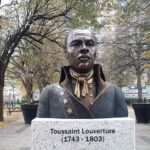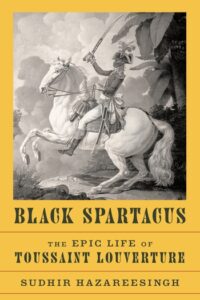Toussaint Louverture and the Haitian Revolution

 Review: Sudhir Hazareesingh, Black Spartacus: The Epic Life of Toussaint Louverture (New York: Farrar, Straus and Giroux, 2020)
Review: Sudhir Hazareesingh, Black Spartacus: The Epic Life of Toussaint Louverture (New York: Farrar, Straus and Giroux, 2020)
By Dan Davison
The Haitian Revolution of 1791-1804 is increasingly recognized as at least as historically significant as the American and French Revolutions. It began as a slave revolt in what was then the French colony of Saint-Domingue. The rebellion brought about the abolition of slavery in Saint-Domingue in 1793 and across the whole French Empire in 1794.
In 1802, Napoleon Bonaparte reintroduced slavery in several French colonies and sent an invading force to Saint-Domingue to restore colonial rule. This turned the Haitian Revolution into a war of independence against France. It ended with Haiti becoming the first state in history to ban both slavery and the slave trade unconditionally from its inception.
The Haitian Revolution shattered the racist assumption that black Africans could never liberate and govern themselves, hastened the demise of the Transatlantic Slave Trade, and became an important point of reference in the American Civil War and other subsequent struggles. No major player in the revolution is as widely celebrated as Toussaint Louverture, a black former slave who rose to command Saint-Domingue’s republican army and govern the colony.
Thought to have been born circa 1740 and freed in 1776, Louverture led his people to freedom against the imperial forces of Britain, Spain, and France. He adopted his surname from the French word for “opening”. Contemporaries saw Louverture’s meteoric rise as an embodiment of the revolution’s world-changing nature. French admirers hailed him as “the Black Spartacus” – a moniker Louverture embraced. In 1802, Louverture was arrested at a parley by French Division General Jean-Baptiste Brunet and deported to France, where he died in prison the following year.
Writing about the Haitian Revolution almost inevitably invites comparisons with C.L.R. James’ masterpiece The Black Jacobins (1938). In that landmark study, James examined the deep connections between the French and Haitian Revolutions, the influence of Enlightenment thought on Louverture and other Saint-Domingue revolutionaries, and how the Haitian Revolution actualized the ideas of liberty, equality, and fraternity to an even greater extent than the French Revolution.
In Black Spartacus, Sudhir Hazareesingh seeks to complicate this picture, drawing on a wealth of archival material to build the most complete biography of Louverture to date. In doing so, Hazareesingh brings out underappreciated dimensions of the ideological context in which Louverture operated, shedding light on some of the more complex aspects of Louverture’s historical role and political vision.
The first thing I should praise about Black Spartacus is Hazareesingh’s prose. While the book’s main body of text is almost 400 pages long, it is both easy and compelling to read. This is because Hazareesingh maintains an atmosphere of excitement without excessively stylizing his narration. Whether on the battlefield or at the negotiating table, Hazareesingh lets the dynamism of Louverture’s personality and era speak for itself.
We can draw both historical and political lessons from Hazareesingh’s reappraisal of Louverture’s life and times. On the historical side, we learn that is there is a great deal of truth in the classic account that Louverture drew on Enlightenment ideas and was proud to be associated with them. He prominently positioned a bust of the Abbé Raynal in his offices (p. 100). Nevertheless, Louverture was never a mere disciple: he drew ideas from various inspirations and put his own twist on them.
For instance, on his table Louverture kept a quarto edition of Guillaume-Thomas Raynal and Denis Diderot’s revolutionary, late Enlightenment pamphlet Histoire philosophique des Deux Indes (1770), which denounced slavery and warned that failing to emancipate the slaves would lead to “terrible reprisals” against the colonists. However, Raynal, Diderot, and other French Enlightenment thinkers did not expect that enslaved black people would emancipate themselves in the name of universalist republican values. In successfully leading the Saint-Domingue slave revolt, Louverture “not only reappropriated the Histoire philosophique, but brought the text to life in a glorious display of erudition, swagger and wit” (p. 11).
As Hazareesingh demonstrates, there was a similar creative adaptation in Louverture’s relationship to Mackandalism. Captured and executed in 1758, François Mackandal was a leader of the marrons; that is, slaves who escaped and formed bands of free men in the forests. He is believed to have set up an elaborate, conspiratorial organization that used vodou rituals to cement its ties and aimed to overthrow the slave owners with such methods as poisoning. Although historians have questioned the scale and even the existence of this conspiracy, Mackandal quickly became a legend in Saint-Domingue, capturing the imagination of black rebels and inspiring terror among the whites.
Unlike Mackandal, Louverture believed in working with Saint-Domingue’s European settler population. He also would have opposed the killing of black slaves by Mackandal’s agents. Nevertheless, Louverture’s “subsequent political thinking shows that he was inspired by the Mackandalist ambition to create a common consciousness among black slaves, by the movement’s appeal to their aspirations for liberty, and by its goal to forge an efficient revolutionary organization which could project its influence across the different parts of the colony” (p. 36).
From Louverture’s innovative approach to Mackandalist and European Enlightenment values to his frequent hybridization of vodou ritual, Catholic moral teachings, and Taino natural mysticism, Black Spartacus paints a striking image of a figure who always sought to push ideas beyond their limits. This resulted in a highly original form of republicanism committed to the ideals of popular sovereignty, the common good, the equal dignity of citizens, and freedom from external domination, which “held up the enticing prospect of a multiracial community of equals, while giving the colony’s black citizens responsibility for defending the revolutionary order” (p. 12). At the heart of this lay a view of citizenship that “represented a much bolder vision of brotherhood than that of the French jacobins”, which Louverture developed “by grappling with the specific circumstances of Saint-Domingue, notably the issue of race” (p. 100).
At the same time, Louverture had more than a few complications. He owned at least one slave between his emancipation and the start of the revolution (p. 30). During the slave rebellion, Louverture initially fought with Spain against revolutionary France and “was genuinely drawn to certain aspects of royalism – notably its belief in providential leadership and the values of duty, sacrifice, and honour” (p. 57). However, one should bear in mind that, in the early stages of both the French and Haitian Revolutions, France was not yet a republic, the French revolutionary authorities had not yet committed to abolition, and Louverture was tactically wary of distancing himself from key rebel commanders in Saint-Domingue who still flew the royalist banner.
Louverture’s most contradictory qualities came in the wake of his 1801 Constitution of Haiti, which made him Governor for Life. Believing he needed to restore Saint-Domingue’s plantation economy in order to revive its agricultural exports, Louverture introduced a fiercely disciplinarian regime enforced by his army commanders. Under this regime, workers could not leave the plantations without permission, fugitives were treated with the same harshness as military deserters, and citizens caught harboring vagrants were penalized. Unsurprisingly, this “brought back echoes of slavery for Saint-Domingue’s black masses, even though they received the legal tariff – one quarter of the harvest – as payment for their labour” (p. 277). While Hazareesingh convincingly argues that it would be wrong to surmise that Louverture had abandoned the principle of revolutionary fraternity, there is no denying that his practical understanding of this principle was strongly paternalistic and that, “in his relentless drive to revive Saint-Domingue’s plantation economy, Toussaint became increasingly trapped in an authoritarian spiral” (p. 278).
This brings me to the political lessons we can draw from Black Spartacus. For all his favorable qualities, Louverture’s paternalistic approach to government and use of military officers in civilian administration clearly illustrate his Bonapartist or Caesarist leanings. In this respect, I am reminded of Hal Draper’s splendid explication of Marx’s New American Cyclopaedia entry on Simon Bolívar, another historically significant military and political leader in the Age of Revolutions. As Draper explains, Marx was grappling with the central problem of Bolívar’s position as a militaristic authoritarian spearheading a genuinely progressive movement against colonial rule, which has important implications for how the international left should approach current examples of so-called “progressive” despots in the Global South.
This is not to imply that we should discard Louverture’s legacy. Were it not for Louverture’s skills and ideas, and where he placed himself at key points, the Haitian Revolution might have failed. Similarly, Louverture’s richly universalist republicanism, forged in the crucible of a black revolution against slavery and colonialism, provides an important counter to those modern left currents that dismiss universalism as nothing more than white Eurocentrism. My point is that, while individual leaders can prove historically decisive, even the most capable leaders are often overtaken by the boldest layers of the movements they head and need to be kept democratically accountable and under pressure from below.
With this year’s worldwide renewal of the Black Lives Matter protests, readers could hardly ask for a better time to revisit the Haitian Revolution and Black Spartacus is as good a place to start as any.